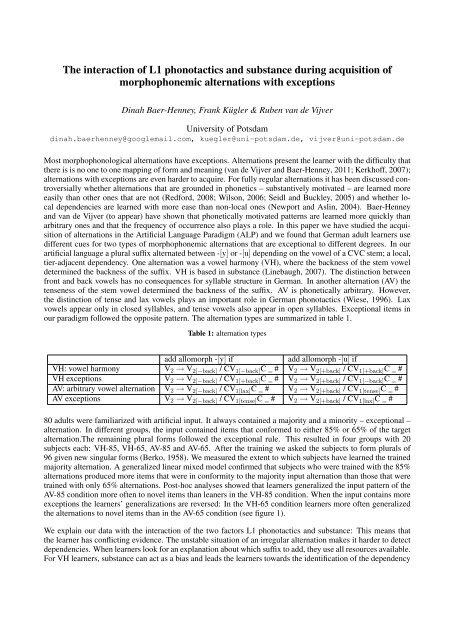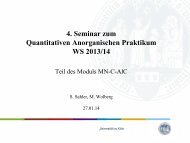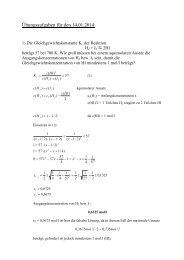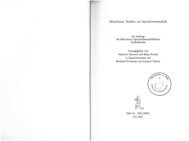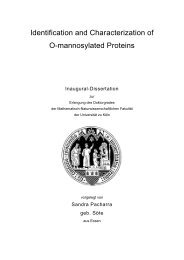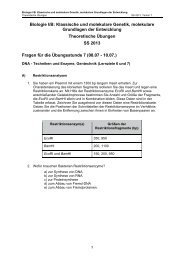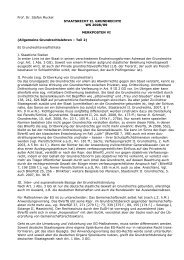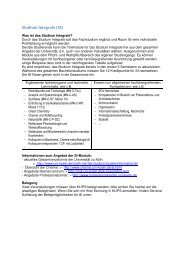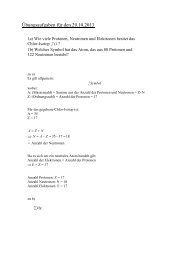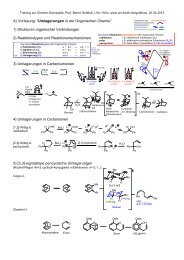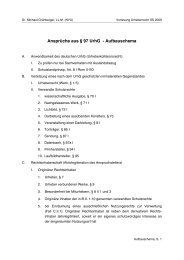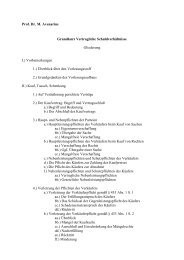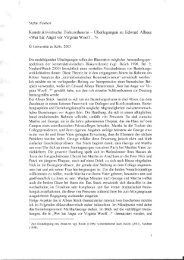The interaction of L1 phonotactics and substance during acquisition ...
The interaction of L1 phonotactics and substance during acquisition ...
The interaction of L1 phonotactics and substance during acquisition ...
Create successful ePaper yourself
Turn your PDF publications into a flip-book with our unique Google optimized e-Paper software.
<strong>The</strong> <strong>interaction</strong> <strong>of</strong> <strong>L1</strong> <strong>phonotactics</strong> <strong>and</strong> <strong>substance</strong> <strong>during</strong> <strong>acquisition</strong> <strong>of</strong><br />
morphophonemic alternations with exceptions<br />
Dinah Baer-Henney, Frank Kügler & Ruben van de Vijver<br />
University <strong>of</strong> Potsdam<br />
dinah.baerhenney@googlemail.com, kuegler@uni-potsdam.de, vijver@uni-potsdam.de<br />
Most morphophonological alternations have exceptions. Alternations present the learner with the difficulty that<br />
there is is no one to one mapping <strong>of</strong> form <strong>and</strong> meaning (van de Vijver <strong>and</strong> Baer-Henney, 2011; Kerkh<strong>of</strong>f, 2007);<br />
alternations with exceptions are even harder to acquire. For fully regular alternations it has been discussed controversially<br />
whether alternations that are grounded in phonetics – substantively motivated – are learned more<br />
easily than other ones that are not (Redford, 2008; Wilson, 2006; Seidl <strong>and</strong> Buckley, 2005) <strong>and</strong> whether local<br />
dependencies are learned with more ease than non-local ones (Newport <strong>and</strong> Aslin, 2004). Baer-Henney<br />
<strong>and</strong> van de Vijver (to appear) have shown that phonetically motivated patterns are learned more quickly than<br />
arbitrary ones <strong>and</strong> that the frequency <strong>of</strong> occurrence also plays a role. In this paper we have studied the <strong>acquisition</strong><br />
<strong>of</strong> alternations in the Artificial Language Paradigm (ALP) <strong>and</strong> we found that German adult learners use<br />
different cues for two types <strong>of</strong> morphophonemic alternations that are exceptional to different degrees. In our<br />
artificial language a plural suffix alternated between -[y] or -[u] depending on the vowel <strong>of</strong> a CVC stem; a local,<br />
tier-adjacent dependency. One alternation was a vowel harmony (VH), where the backness <strong>of</strong> the stem vowel<br />
determined the backness <strong>of</strong> the suffix. VH is based in <strong>substance</strong> (Linebaugh, 2007). <strong>The</strong> distinction between<br />
front <strong>and</strong> back vowels has no consequences for syllable structure in German. In another alternation (AV) the<br />
tenseness <strong>of</strong> the stem vowel determined the backness <strong>of</strong> the suffix. AV is phonetically arbitrary. However,<br />
the distinction <strong>of</strong> tense <strong>and</strong> lax vowels plays an important role in German <strong>phonotactics</strong> (Wiese, 1996). Lax<br />
vowels appear only in closed syllables, <strong>and</strong> tense vowels also appear in open syllables. Exceptional items in<br />
our paradigm followed the opposite pattern. <strong>The</strong> alternation types are summarized in table 1.<br />
Table 1: alternation types<br />
add allomorph -[y] if add allomorph -[u] if<br />
VH: vowel harmony V2 → V 2[−back] / CV 1[−back]C _ # V2 → V 2[+back] / CV 1[+back]C _ #<br />
VH exceptions V2 → V 2[−back] / CV 1[+back]C _ # V2 → V 2[+back] / CV 1[−back]C _ #<br />
AV: arbitrary vowel alternation V2 → V 2[−back] / CV 1[lax]C _ # V2 → V 2[+back] / CV 1[tense]C _ #<br />
AV exceptions V2 → V 2[−back] / CV 1[tense]C _ # V2 → V 2[+back] / CV 1[lax]C _ #<br />
80 adults were familiarized with artificial input. It always contained a majority <strong>and</strong> a minority – exceptional –<br />
alternation. In different groups, the input contained items that conformed to either 85% or 65% <strong>of</strong> the target<br />
alternation.<strong>The</strong> remaining plural forms followed the exceptional rule. This resulted in four groups with 20<br />
subjects each: VH-85, VH-65, AV-85 <strong>and</strong> AV-65. After the training we asked the subjects to form plurals <strong>of</strong><br />
96 given new singular forms (Berko, 1958). We measured the extent to which subjects have learned the trained<br />
majority alternation. A generalized linear mixed model confirmed that subjects who were trained with the 85%<br />
alternations produced more items that were in conformity to the majority input alternation than those that were<br />
trained with only 65% alternations. Post-hoc analyses showed that learners generalized the input pattern <strong>of</strong> the<br />
AV-85 condition more <strong>of</strong>ten to novel items than leaners in the VH-85 condition. When the input contains more<br />
exceptions the learners’ generalizations are reversed: In the VH-65 condition learners more <strong>of</strong>ten generalized<br />
the alternations to novel items than in the AV-65 condition (see figure 1).<br />
We explain our data with the <strong>interaction</strong> <strong>of</strong> the two factors <strong>L1</strong> <strong>phonotactics</strong> <strong>and</strong> <strong>substance</strong>: This means that<br />
the learner has conflicting evidence. <strong>The</strong> unstable situation <strong>of</strong> an irregular alternation makes it harder to detect<br />
dependencies. When learners look for an explanation about which suffix to add, they use all resources available.<br />
For VH learners, <strong>substance</strong> can act as a bias <strong>and</strong> leads the learners towards the identification <strong>of</strong> the dependency
Figure 1: Mean distance from chance level <strong>of</strong> answers in all groups VH-85, AV-85, VH-65, AV-65<br />
between trigger <strong>and</strong> suffix. For AV learners, the German <strong>phonotactics</strong> can help. For the 85% learners AV was<br />
the easier alternation than VH, hence it turned out that for them the <strong>phonotactics</strong> <strong>of</strong> <strong>L1</strong> are the more reliable<br />
cue because it helps the learner to group the stems on the basis <strong>of</strong> their vowel. Ott (2011) found that in German<br />
this grouping is used to distinguish nouns from verbs <strong>and</strong> that speakers are aware <strong>of</strong> the generalization that a<br />
consonant cluster preceded by a tense vowel are separated by a morpheme boundary. Also, Germans use the<br />
tenseness distinction to identify the obstruents’ status <strong>of</strong> voice (Kleber et al., 2010). However, with an even<br />
more unstable input, the 65% learners rely more on <strong>substance</strong> as a cue. With less regularity the substantively<br />
based VH has been discovered more easily <strong>and</strong> generalized to more items than AV, which was not substantively<br />
based. To summarize, we show that depending on type <strong>and</strong> regularity <strong>of</strong> an alternation the learners make use<br />
<strong>of</strong> different cues to support the <strong>acquisition</strong> <strong>of</strong> morphophonemic alternations.<br />
References<br />
Berko-Gleason, J. 1958. <strong>The</strong> Child’s Learning <strong>of</strong> English morphology. Word 14, 150–177.<br />
Baer-Henney, D., van de Vijver, R. to appear. On the Role <strong>of</strong> Substance, Locality <strong>and</strong> Amount <strong>of</strong> Exposure in<br />
the Acquisition <strong>of</strong> Morphophonemic Alternations. Laboratory Phonology.<br />
Kerkh<strong>of</strong>f, A. 2007. Acquisition <strong>of</strong> Morpho-phonology: <strong>The</strong> Dutch Voicing Alternation. PhD thesis, University<br />
<strong>of</strong> Utrecht.<br />
Kleber, F., John, T., Harrington, J. 2010. <strong>The</strong> Implications for Speech Perception <strong>of</strong> Incomplete Neutralization<br />
<strong>of</strong> Final Devoicing in German. Journal <strong>of</strong> Phonetics 38, 185–196.<br />
Linebaugh, G. 2007. Phonetic Grounding <strong>and</strong> Phonology: Vowel Backness Harmony <strong>and</strong> Vowel Height<br />
Harmony. PhD thesis, University <strong>of</strong> Illinois.<br />
Newport, E. L., Aslin, R. 2004. Learning at a Distance I: Statistical Learning <strong>of</strong> Non-adjacent Dependencies.<br />
Cognitive Psychology 48(2), 127–162.<br />
Ott, S. 2011. Feld – fällt – fehlt: Untersuchungen zur Phonologie-Morphosyntax-Schnittstelle bei Kindern<br />
und Erwachsenen. PhD thesis, University <strong>of</strong> Potsdam.<br />
Redford, M. 2008. Production Constraints on Learning Novel Onset Phonotactics. Cognition 107(3), 785–<br />
816.<br />
Seidl, A., Buckley, E. 2005. On the Learning <strong>of</strong> Arbitrary Phonological Rules. Language Learning <strong>and</strong><br />
Development 1(3&4), 289–316.<br />
van de Vijver, R., Baer-Henney, D. 2011. Acquisition <strong>of</strong> Voicing <strong>and</strong> Vowel Alternations in German. Proc.<br />
35th BUCLD Boston, 603–615.<br />
Wiese, R. 1996. <strong>The</strong> Phonology <strong>of</strong> German. Oxford: Clarendon Press.<br />
Wilson, C. 2006. Learning Phonology with Substantive Bias: An Experimental <strong>and</strong> Computational Study <strong>of</strong><br />
Velar Palatalization. Cognitive Science 30(5), 945–982.


